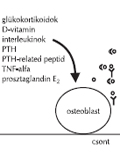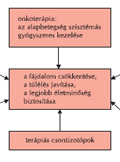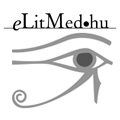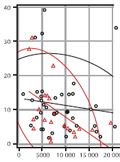The eLitMed.hu medical portal uses computer cookies for convenient operation. Detailed information can be found in the Cookie-policy.
LAM KID - 2011;1(02)
Content
[Inhibition of receptor activator of nuclear kappa-B ligand: pathophysiology and preclinical data]
[Bone remodeling is a lifelong process, in which the balanced functions of osteoclasts and osteoblasts have a key role. In certain conditions, for example during the dramatical hormonal changes in the postmenopausal period, the upset of this balance leads to a pathologically increased bone loss. Such conditions lead to an increased bone loss, which results in an increased risk of fractures. Bone resorption is primarily regulated by a member of the tumor necrosis factor family, receptor activator of nuclear factor κB ligand, which plays a central role in the development, function and survival of osteoclasts. Catabolic effects of this ligand is inhibited by another member of the tumor necrosis factor family, osteoprotegerin, which binds to the ligand and prevents its interaction with its receptor, the receptor activator of nuclear factor κB. Osteoclast activity is at least partly dependent on the relative balance of the ligand and osteoprotegerin. It has been shown in a number of animal models that inhibition of the ligand markedly decreases bone resorption and increases cortical and cancellous bone volume, density and strength, without having any significant effect on other organs. On the basis of these findings, inhibition of receptor activator of nuclear κB ligand is a promising therapy of conditions characterised by increased bone loss. In phase 3 clinical trials, denosumab therapy significantly increased bone mineral density at various regions of the skeleton and significantly decreased the levels of bone turnover markers compared with placebo and alendronate therapy, and significantly decreased the incidence of new vertebral, total hip and nonvertebral fractures compared with placebo. On the basis of these findings, denosumab therapy offers a novel, revolutionary solution for the treatment of postmenopausal osteoporosis.]
[Pain relief in metastatic bone disease]
[Metastatic bone disease is a hallmark of distant relapse of a number of solid tumours. The treatment of bone metastases is palliative, the main goal is to relieve pain, whereas it’s also important to reduce the risk of bone fractures, prolong survival and maintain the physical activity of patients. Pain is one of the most common symptoms of bone metastases, and state-of-the-art pain relief has an important role in maintaining the patients’ quality of life. Therapies to control pain include drug therapy, radiotherapy, surgery, systemic oncotherapy, such as chemotherapy and/or hormone therapy, multibone radioisotope therapy and administration of bisphosphonates. Regarding the relief of pain caused by malignant tumours, the guidelines developed by the World Health Organization should be followed. The algorithm of pain relief starts with assessment of the pain’s intensity and includes both pharmacological and nonpharmacological interventions. Analgesics used for pain relief include nonopioids, opioids and adjuvant agents. The pain can be efficiently relieved with the combined use of modern analgesics in the great majority of patients.]
[Pain relief in the neurologist’s view]
[Pain, on the basis of its anatomical origin, can be nociceptive (somatic, visceral) or neuropathic, that is, occuring as a direct consequence of a lesion or disease affecting the somatosensory system. The past few years’ epidemiological studies showed that chronic neuropathic pain affects 7-8% of the general population. Diagnosis of neuropathic pain can be established without instrumental examinations, with the help of validated tests that can be used by any physician. Neuropathic pain greatly deteriorates the patients’ quality of life, and the effect of traditional analgesics is insufficient for its treatment. Thus, it is important to know those treatment procedures and drugs that have been proved to be efficient for relieving neuropathic pain.]
[Pain management in rheumatology]
[Pain is the most common symptom in rheumatology, which can be of mechanical or inflammatory origin, acute and chronic, nociceptive, neuropathic and psychogenic. Pain can be relieved by analgesics, nonsteroidal anti-inflammatory drugs, opioids, adjuvants and special drugs depending on the etiology, for example a gout attack can be stopped by colchicine. For pain relief, we use therapeutic guidelines of the World Health Organization (WHO), which recommends the use of analgesics, NSAIDs and adjuvants as the first step, weaker opioids as the second, and strong opioids as the third step. In rheumatology, the first step's drugs are generally used. If possible, NSAIDs should be administered briefly, potentially combined with analgesics and muscle relaxants. If pain management is insufficient, tramadol should be given. Pain relief in rheumatology also include the use of local and intraarticular injections, physiotherapy, TENS and balneotherapy. Complex therapies that combine the above mentioned methods is often more effective than the use of medications only.]
[Connections of bone turnover and energy homeostasis in women]
[BACKGROUND - A new discovery of the past decade has been the previously unknown relationship between the bone metabolic unit and energy homeostasis. On the basis of data from previous animal and clinical studies, osteocalcin has been considered the major mediator of this relationship. Cathepsin K is a cysteine protease type osteolytic enzyme, which has a role in bone resorption, and which is a pharmaceutical target in the treatment of osteoporosis and bone metastasis. According to data from animal studies, its deficiency or selective inhibition decreases the differentiation of preadipocytes, body weight and serum levels of insulin and glucose in obese mice. The aim of our study was to elucidate the role of cathepsin K in the human bone - metabolic axis in women (n=66). PATIENTS AND METHODS - 21 healthy and 45 glucose intolerant women were examined. OGTT, IVGTT and hyperinsulinaemic euglycaemic clamp were performed to assess carbohydrate homeostasis, insulin secretion, whole-body and muscle glucose utilization (M-1 and M-3). Circulating levels of bone markers and adipokines were measured, and DEXA was used to measure BMD, fat and muscle mass. RESULTS - Cathepsin K levels showed a significant (p<0.05), negative correlation with BMI, body fat percent and OGTT glucose and insulin area under the curve (AUC), and a positive correlation with M values. No correlation was found between cathepsin K levels and IVGTT measurements. CONCLUSION - Cathepsin K - in women - is not only a participant of the bone metabolism - energy homeostasis axis. Its role in human glucose homeostasis differs from what could be expected on the basis of animal experiments, because increasing cathepsin K levels indicate, paradoxically, improving metabolic state in women. Our data suggest that insulin regulation of cathepsin K is mediated by the incretin system.]
[Osteoporotic patient’s use of prescription drugs - pilot study]
[BACKGROUND - In Hungary, the number of the highest mortality hip fractures is between 12 000-15 000 per year. The cost of treating hip fractures is several times higher than that of preventive medical therapy. Thus, the compliance of patients with osteoporosis is of great importance. METHODS - Using the informatical database of St. András Rheumatology Hospital at Héviz, we collected one year’s prescription drugs for osteoporosis and compared them with the number of drugs obtained by the patients, determined from National Health Insurance data. RESULTS - In general, the patients obtained 75% of prescription drugs. From the 4354 boxes of prescribed antiporotics, 3637 contained bisphosphonate (not considering vitamin D and calcium). Within this group, 88% of combination preparations were obtained, which is a greater ratio than that of non-combination bisphosphonates (84%). CONCLUSIONS - On the basis of our results, we posit that prescription of a combination preparation somewhat improves the patients’ compliance. The low concordance of vitamin D and calcium preparations is worrying.]
[Current treatment and rehabilitation of the hip fractures - The role of orthopedic surgeons in the investigation and treatment of osteoporosis]
[The treatment of proximal femoral fractures is one of the most common surgical indications in traumatology, on the other hand, it requires a significant proportion of health expenditures. The structure of our society is going to shift toward the older generation in the next decades, which increases the importance of the above factors. New implants and surgical techniques appear in order to make the treatment more effective, thus allowing the patient’s early rehabilitation. In this article, we summarise the diagnosis and treatment of hip fractures, the most serious consequence of osteoporosis, and describe the results of rehabilitation. We describe the role and possibilities of orthopedic surgeons in the investigation and treatment of patients with osteoporotic hip fractures as well as possibilities of tertiary prevention and suggest possibilities of cooperation among the co-professions dealing with osteoporosis in the treatment of this patient group.]
1.
Clinical Neuroscience
[Headache registry in Szeged: Experiences regarding to migraine patients]2.
Clinical Neuroscience
[The new target population of stroke awareness campaign: Kindergarten students ]3.
Clinical Neuroscience
Is there any difference in mortality rates of atrial fibrillation detected before or after ischemic stroke?4.
Clinical Neuroscience
Factors influencing the level of stigma in Parkinson’s disease in western Turkey5.
Clinical Neuroscience
[The effects of demographic and clinical factors on the severity of poststroke aphasia]1.
2.
3.
4.
5.











